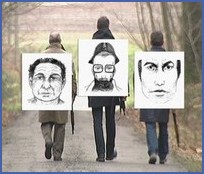| | | Nicolas de Kerchove d’Ousselghem |  |
|
+8luanda David Teacher dim james007 MAXANCE Henry K HERVE 12 participants | |
| Auteur | Message |
|---|
Etienne
Nombre de messages : 1691
Date d'inscription : 26/11/2015
 |  Sujet: Re: Nicolas de Kerchove d’Ousselghem Sujet: Re: Nicolas de Kerchove d’Ousselghem  Ven 25 Mai 2018 - 18:03 Ven 25 Mai 2018 - 18:03 | |
| Bonjour,
Via Tel Aviv. Cela fait sourire.
Je ne me souviens pas que nos F104 laissaient une traînée noire dans leur sillage. |
|   | | HERVE
Nombre de messages : 21423
Date d'inscription : 08/12/2009
 |  Sujet: Re: Nicolas de Kerchove d’Ousselghem Sujet: Re: Nicolas de Kerchove d’Ousselghem  Ven 25 Mai 2018 - 18:07 Ven 25 Mai 2018 - 18:07 | |
|
Intéressant de voir qu'une société de Georges Gutelman (grand ami de Jean Gol dont Nicolas de Kerchove d’Ousselghem était le chef de cabinet) contribuait à une opération du gouvernement israëlien... très probablement en plein accord avec les organisateurs de IranContra : John K. Singlaub, Oliver North, Robert K. Brown, Bill Casey, etc
Rien n'indique que Wilfried Martens le savait.
Par contre, Wilfried Martens était au courant de l'opération Moïse pour le transfert des Falachas d'Ethiopie vers Israël :
https://www.lecho.be/actualite/archive/il-y-a-vingt-ans-tea-sauvait-9-300-juifs-ethiopiens/8819156.html
|
|   | | HERVE
Nombre de messages : 21423
Date d'inscription : 08/12/2009
 |  Sujet: Re: Nicolas de Kerchove d’Ousselghem Sujet: Re: Nicolas de Kerchove d’Ousselghem  Ven 25 Mai 2018 - 18:40 Ven 25 Mai 2018 - 18:40 | |
|
Beaucoup d'anciens du CEPIC se retrouveront au sein du PRL de Jean Gol, ainsi que des personnalités comme Robert Close dont l'arrivée au PRL d'Uccle fut saluée par un discours de son grand ami Armand De Decker. Jean Gol avait attribué à Robert Close une place éligible sur la liste PRL du Sénat.
|
|   | | HERVE
Nombre de messages : 21423
Date d'inscription : 08/12/2009
 |  Sujet: Re: Nicolas de Kerchove d’Ousselghem Sujet: Re: Nicolas de Kerchove d’Ousselghem  Sam 26 Mai 2018 - 9:59 Sam 26 Mai 2018 - 9:59 | |
| https://www.law.kuleuven.be/lib/plone/tijdschriften/jt/1989/1989-5496-117.pdf  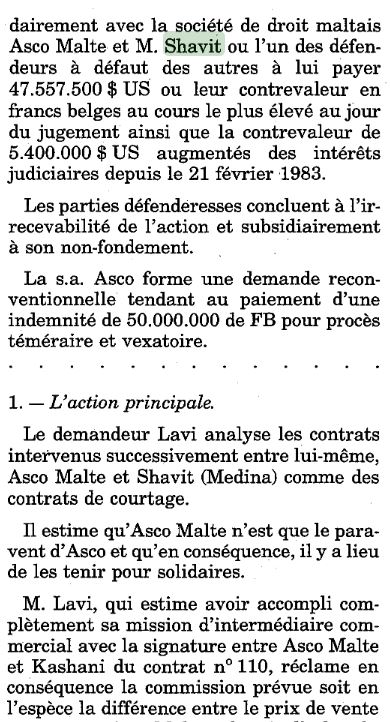 (...) |
|   | | HERVE
Nombre de messages : 21423
Date d'inscription : 08/12/2009
 |  Sujet: Re: Nicolas de Kerchove d’Ousselghem Sujet: Re: Nicolas de Kerchove d’Ousselghem  Sam 26 Mai 2018 - 13:50 Sam 26 Mai 2018 - 13:50 | |
| |
|   | | HERVE
Nombre de messages : 21423
Date d'inscription : 08/12/2009
 |  Sujet: Re: Nicolas de Kerchove d’Ousselghem Sujet: Re: Nicolas de Kerchove d’Ousselghem  Sam 26 Mai 2018 - 14:12 Sam 26 Mai 2018 - 14:12 | |
|
2 Feb. 1987
_ _ _
https://www.nytimes.com/1987/02/02/world/huge-illegal-deal-on-arms-for-iran-was-known-to-us.html
HUGE ILLEGAL DEAL ON ARMS FOR IRAN WAS KNOWN TO U.S.
By STUART DIAMOND WITH RALPH BLUMENTHAL
High Pentagon intelligence officials learned more than a year ago that private arms dealers were trying illegally to ship 39 American fighter planes and vast amounts of other weapons to Iran, but the officials did not stop the sales, according to confidential documents and participants who informed the Government.
The illegal efforts were allowed to continue because the military officials hoped to gain intelligence information, including data on Iran and access to advanced Soviet tanks captured from Iraq by Iran, the sources said.
The Pentagon confirmed that it was told as early as December 1985 of the private efforts, which began in 1983. But various arms dealers contended in interviews that some high Government officials knew of the project by early 1984. 150 People Interviewed
The private efforts continued as the Reagan Administration was arranging the official sales of arms to Iran that are now the subject of inquiries by two Congressional committees and a Federal special prosecutor.
Information about the private efforts -named the Demavand project, for Iran's highest mountain - was obtained by The New York Times from more than 4,000 pages of confidential telexes, contracts, correspondence and other documents and interviews with 150 Government officials, arms dealers, intelligence sources and others over the last eight weeks.
Continue reading the main story
No one interviewed was sure that fighter planes were delivered to Iran in the Demavand project, but Iraqi military sources have said that a greater number of F-4's have been flying for Iran since last fall. The total value of the arms contracted for in the project was more than $1 billion. Wide-Ranging Disclosures
These disclosures emerged from the sources and documents:
* Government officials were aware of wider efforts to ship American arms to Iran, and far larger amounts of American weapons were involved than have been previously reported. The Administration has acknowledged Government sales of arms to Iran of $12 million to $42 million.
* Egypt, which has criticized the United States for selling arms to Iran, in 1985 guaranteed money and offered planes to private dealers trying to ship the F-4's to Iran through Turkey. Egyptian military officials said they did not know the planes were destined for Iran.
* Major European financial institutions had extensive contacts with the arms dealers, providing bank accounts and money and in one case co-signing a sales contract for the planes.
* John K. Singlaub, a retired Army major general who helped the Administration supply the Nicaraguan rebels, also served on the board of a Manhattan arms company that became involved in the Demavand project and whose owner pleaded guilty to smuggling arms to Iran. General Singlaub says he knew of no illegal dealings by the company.
* One intelligence consultant complained that 48 hours after he gave confidential information about the Demavand project to the head of Marine Corps counterintelligence in Washington, high Iranian military officials had details of the private discussion.
Evidence collected by The Times suggests a measure of overlap between the private and official efforts. The line between what was official and unofficial became blurred, and arms dealers now assert that they were acting under the umbrella of official approval.
The United States had declared an embargo on arms sales to Iran after Iran seized American hostages in 1979. The Reagan Administration continued to support that ban publicly although it sent its first shipment of arms to Iran in August 1985 and although President Reagan signed an order in January 1986 authorizing further official arms shipments to Teheran.
The investigation by The Times gives further indications that senior military officials in Washington, including aides at the Joint Chiefs of Staff and Marine Corps counterintelligence, were aware of illegal private arms sales to Iran, in addition to the officially arranged sales that are now known as part of the Iran-contra arms case.
The Times reported last month that two United States Army colonels had been implicated by Army investigators in illegal efforts to sell arms to Iran for private gain while they were on active duty in sensitive European assignments. Pentagon authorities were informed of the efforts but did not prosecute. Both men denied any wrongdoing.
In the complex and often cloudy world of international arms traffic, it can be difficult to differentiate among various deals and intrigues. But the colonels' activities appear to have been separate from the Demavand project. They also seem to be separate from a $2 billion arms sales effort that was at the center of a Government sting operation in Manhattan, in which undercover Customs agents gained 17 indictments in April 1986 by infiltrating what they have described as an illegal arms deal in progress. THE DEMAVAND PROJECT: A START IN EARLY 80's
The Demavand project, dating to 1983, started earlier than either the sting operation or the Administration's secret sales to Iran. The project was originally to include sales of Harpoon and Sidewinder missiles, 39 F-4 fighter planes, 50 M-48 tanks and at least 25 attack helicopters.
Although accounts differ on how many weapons were actually delivered to Iran, the sources and documents show that contracts were signed, that millions of dollars in guarantees were deposited in bank accounts by the sellers and the Iranian buyers and that American military officials were discussing parts of the transaction as late as last August.
Several arms dealers asserted that the Demavand operation was eventually overtaken by the Administration's official efforts, which were disclosed in November.
Sources familiar with sales of American arms to Iran said the total ddeliveries to the Teheran Government went far beyond the 2,008 antitank missiles and parts for 235 Hawk missiles that the Administration has acknowledged selling to Iran.
Until the Administration started to sell Iran limited amounts of arms from American stocks, American arms bound for Iran had to be found in third countries, which were legally bound by their Pentagon contracts to supply certificates to the United States about the ultimate destination of the arms they were selling. Since sales to Iran were barred, sellers had to arrange for false certification of the ultimate destination or circumvent this requirement.
But arms dealers say these these legal distinctions were treated as formalities. They maintain that the total of American arms delivered to Iran from the Demavand sales, the limited sales the Administration says it authorized beginning in mid-1985 and other efforts included 12,000 antitank missiles as well as $150 million in military spare parts and 200 highly advanced Phoenix air-to-air missiles, at more than $1 million each. AN ELUSIVE BUSINESSMAN AND A C.I.A. OPERATIVE
Among those who provided substantial information about the Demavand operation was Richard J. Brenneke, who drew wide attention in late November by asserting that he had told Vice President Bush's office in February 1986 of secret details about Demavand and other arms sales to Iran and the diversion of Government proceeds to the Nicaraguan rebels, known as contras.
Mr. Brenneke has been publicly identified as an Oregon real estate executive, but in recent interviews he showed The Times evidence that he was employed for 13 years by the Central Intelligence Agency. He also said he had been a freelance consultant for more than 15 years for such organizations as Mossad, the Israeli security agency, as well as French intelligence.
Also giving details in interviews was John H. Delaroque, an elusive French businessman who has been indicted but not apprehended in the New York Customs sting operation on arms sales. He said the Demavand project was widely known in the Government and military.
''Everybody knew about it,'' he said last week by telephone from southern France. ''But the U.S. Government never said to us, 'Stop.' They said, 'Just keep the information flowing.' ''
Business executives and arms dealers admitted that they had an interest in saying their dealings had been Government-sanctioned. Individually, their assertions might be dismissed as self-serving, but many of the sources independently provided precise details and documents that coincided on key points.
Defense lawyers in the $2 billion Customs Government sting operation argued that their clients thought their activities were sanctioned by the Administration. The lawyers argued that Customs Service officials, in setting up the sting operation, were unaware of the new drift in American policy.
The military officials named by participants, when contacted by The Times, referred queries about the Demavand case to Government spokesmen. The spokesmen confirmed that certain key meetings were held and documents received, but they declined to respond in detail, citing the Congressional and grand jury investigations of the Iran-contra affair. A SOURCE'S SOURCES: IRANIANS AND SYRIANS
The Times first learned of Pentagon awareness of the Demavand project in November from Mr. Brenneke, who owns a real estate management firm, G.P.I. Management Inc., in Lake Oswego, Ore. Initially it was unclear how a real estate executive would know such details. In recent interviews, Mr. Brenneke said he had extensive intelligence connections, including contacts with Iranians and Syrians, that gave him access to sensitive arms information.
He provided a letter of reference under a C.I.A. letterhead, dated June 20, 1979, confirming that he had been employed by the agency for 13 years and saying, ''We found him to be thorough, competent and very trustworthy.''
The letter said in part that Mr. Brenneke, who described his C.I.A. work as reconnaissance flights in Vietnam and South America and other tasks he could not discuss, left at his own request and was eligible to be rehired. The C.I.A. said it does not comment on employees.
Mr. Brenneke acknowledged that he was trying at the time to capitalize on his work as an intelligence consultant by dealing in arms himself.
While some of his assertions at first hearing appeared implausible, he provided hundreds of pages of handwritten notes and typed memos dating to 1985 and referring in detail to arms shipments that were then secret and have since been substantially corroborated by recent official disclosures and by the investigation by The Times.
Mr. Brenneke's notes referred to involvement in arms sales to Iran by Israel, by Vice Adm. John M. Poindexter, then the President's national security adviser, and by others whose roles became public only months later.
His notes, some of which have been filed as court documents by lawyers defending people in the $2 billion sting operation, contained references to efforts to trade weapons for hostages. He listed dozens of names and telephone numbers of intelligence agents, arms dealers, Government officials and accounts of his conversations with them about arms sales to Iran.
The Defense Department and intelligence agencies, he said, have been aware for several years that private dealers, including some Americans, have been shipping arms to Iran. He said many of the efforts were permitted as a way of improving relations with Iran.
Mr. Brenneke said he first informed American military officials about the Demavand project in December 1985, partly out of concern that he might have information about illegal actions. His lawyer, Richard H. Muller, took Mr. Brenneke's memos to senior military officials in Washington.
Mr. Brenneke said he had discussions with Lieut. Col. George Alvarez of Marine Corps counterintelligence and with others over the next few months. He said he had been told that he should not to get involved in the project, but that his information would be welcomed. Mr. Brenneke said he had also spoken to J. William Middendorf 2d, a retired Under Secretary of the Navy who is now the American representative to the European Community in Brussels, and to Ralph Johnson, then director of the State Department's European bureau, who was an acquaintance of Mr. Brenneke.
Mr. Middendorf, reached in Brussels, said he did not recall ever talking to Mr. Brenneke. Mr. Johnson did not return repeated telephone calls.
Mr. Muller said ''the highest possible levels'' of the military command knew of the project, but he declined to elaborate. Mr. Delaroque, the French businessman, said the same thing.
In January 1986, Mr. Brenneke said, a top Iranian Air Force official, Col. Kiamars Salahshoor, repeated to him the gist of Mr. Brenneke's phone conversations with Colonel Alvarez. ''There was a major intelligence leak to the Iranians from Mr. Alvarez's office,'' Mr. Brenneke said. A PENTAGON SUGGESTION: IRAN TAPPED THE PHONES
On Friday, a military spokesman denied that there had been any leak through Colonel Alvarez's office and said Mr. Brenneke's call had been made on an unsecured telephone. He suggested that the line might have been monitored by the Iranians.
Colonel Alvarez declined to discuss the matter. A Marine Corps spokesman, Lieut. Col. John Shotwell, said Colonel Alvarez did not recall any phone conversations with Mr. Brenneke.
On May 28, 1986, Mr. Brenneke said, he and two associates whom he brought along as witnesses met with representatives of the Joint Chiefs of Staff to discuss the Demavand case for two and a half hours in Room 2B-869 at the Pentagon.
Mr. Brenneke said the three Pentagon officials were Franklin D. Lomax, Col. Byron R. Hooten of the Air Force and Maj. C. L. Stewart of the Army, who is now a lieutenant colonel. They were attached to the Joint Special Operations Agency, a counter-terrorism unit formed in 1984 in response to the failed attempt to rescue American hostages in Iran in 1980.
Mr. Brenneke said he had requested the meeting because his contacts in Iran had three Soviet T-80 tanks and other materiel that had been captured from Iraq.
The Times reported yesterday that Iran had also promised to give Israel a Soviet-made T-72 tank captured from Iraq as part of an arms deal in early 1985. The T-80 is more advanced than the T-72.
Mr. Brenneke said the Iranians were willing to turn the Soviet equipment over to the United States to open diplomatic discussions and to help their efforts to get American planes. The return of American hostages held in Lebanon might also have been part of the deal, he said.
He said the C.I.A. had been interested in the tanks as early as Dec. 18, 1985, when he was called by an agent from the agency's Los Angeles office. He said the Joint Chiefs office later took over the C.I.A.'s efforts on the tanks. He said he had talks with officials in various Government agencies between December and May, when the Pentagon meeting took place.
Mr. Brenneke said the three Pentagon officers at the May meeting were eager to get the Soviet equipment and knew about the Demavand project. At the session, he said, one of the aides pulled a file folder labeled ''Demavand'' from the drawer of a file cabinet in the office. THE MILITARY'S QUERY: U.S. HOSTAGES' FATE
''They wanted to know whether Demavand was a viable project and how much further can we go as far as military intelligence goes,'' he said. ''They wanted intelligence out of Iran on terrorism and on Iran in general. They also wanted to know if the fate of the hostages could be influenced, and under what circumstances.''
The next day, he said, an Army intelligence official, Lieut. Col. Larry Caylor, visited his hotel room to discuss the matter further. Mr. Brenneke's two companions were also there.
Calls to Colonel Caylor were not returned. A Pentagon spokesman said no Pentagon official would comment on any Iran arms dealings.
Mr. Brenneke said discussions on the matter with American military officials continued until August 1986, when the officials said they had to stop the discussions because of an official project, which they did not describe. The next month the American Government opened a new official channel for arms shipments to Iran. It followed a trip in May to Teheran by Robert C. McFarlane, the former national security adviser, with a planeload of arms that failed to win the release of the hostages.
Mr. Brenneke said one reason he decided to disclose his information now is that he was annoyed that Lieut. Col. E. Douglas Menarchik, a military aide in the Vice President's office, said publicly he did not recall any conversations with Mr. Brenneke. Mr. Brenneke said he had spoken with Colonel Menarchik three times by telephone.
The Pentagon declined to make the three military officials available for interviews. Instead, a spokesman read a prepared statement to The Times saying the three Pentagon officials from the Joint Special Operations Agency took part in a ''normal contractor meeting'' on May 28 but did not recall that Mr. Brenneke was there.
The statement said that at the session ''an unsolicited proposal'' to supply Soviet bloc equipment was made that was later referred to other intelligence officials and then rejected. The statement made no reference to Demavand.
Mr. Brenneke's witnesses, who are involved in an arms manufacturing company in the South and who declined to be publicly identified, corroborated statements made by Mr. Brenneke, who said he brought the witnesses because ''I didn't want the Government officials to forget the meeting sometime later.''
The three said the session was not a normal contractor's meeting but had been arranged for specific discussions of Demavand and the Soviet equipment. The witnesses said they were surprised by the officials' failure to recall Mr. Brenneke since he conducted virtually all of the discussion with them.
The Demavand project had its origins in 1980, when Bernard Veillot, a former French Navy pilot and later an arms dealer, made his first contacts with Iranian officials while flying insecticides from Belgium to Iran, according to an unpublished manuscript, ''Fanning the Flames,'' by Kenneth R. Timmerman. The book by Mr. Timmerman, a Paris-based freelance journalist, is about arms sales to Iran and Iraq and has been purchased by The New York Times Syndicate.
By 1983 Iran, at war with Iraq, was desperate for American military equipment, which represented 95 percent of its weapons. Only a few of the 250 F-4's obtained before the Shah was overthrown in 1979 were still flyable.
Mr. Veillot and Claude Lang, a French arms dealer who associates said had C.I.A. contacts, set up a Panamanian company, Daloa Finance, that handled arms sales to Iran, interviews and records show. Mr. Delaroque, who said he was an associate of Mr. Veillot, asserted that he had high connections in the Iranian military and Government and with American officials.
In February 1983, Mr. Lang said he met in Washington with a retired Air Force general, Swede Svendsen, to discuss the tanks that were to be part of the Demavand deal. General Svendsen was a consultant to the Washington lobbying concern of Alcalde, Henderson, O'Bannon & Rousselot, which had on its staff many former high Government and military officials.
General Svendsen, who now runs a military consulting company in San Antonio, said in an interview that he was a friend of retired Richard V. Secord, a retired Air Force major general who has emerged as a major figure in the Iran-contra arms case, but that the two did not have any business dealings.
He also said he never consummated the tank deal. ''I found out it was an Iranian thing, and I left,'' he said. He said he met in Washington with Mr. Lang and in France with Mr. Lang and Mr. Veillot in early 1984.
General Svendsen also said he had introduced Mr. Lang and Mr. Veillot to James Fees, the head of a Geneva consulting company, Tradeco. Mr. Fees, a former State Department official, said the dealers had wanted F-4 planes from Egypt, ostensibly for Paraguay. He said he had become suspicious and had broken off further contacts. A MYSTERIOUS OFFICIAL: WHO WAS MR. BOYLE?
Mr. Delaroque, Mr. Brenneke, Mr. Lang and other sources said key support for the Demavand project was provided in early 1984 by a Government official they identified only as ''Mr. Boyle,'' at the National Security Agency, the top-secret agency that conducts electronic eavesdropping and monitoring of communications around the world. No first name was provided, and those interviewed said Boyle may have been a code name.
Also associated with the Demavand project was Paul S. Cutter, also known as Paul Sjeklocha, a former C.I.A. analyst and translator who is serving a prison sentence in Arizona for trying to smuggle arms to Iran. He is appealing his sentence on the ground that his activities were Government-sanctioned.
To help get the Demavand project planes, another American, Michael Austin, joined the deal, documents show. Mr. Austin headed Manhattan concerns called Austin Aerospace and Universal Aerospace. The Austin Aerospace board of advisers was composed of several retired military officers listed on a company letterhead obtained by Customs intelligence officials, who investigated the company.
The advisers included General Singlaub; Brig. Gen. Heine Aderholt, who is retired from the Air Force and was commander of the military assistance command in Thailand, and Col. W. J. Knight, also retired from the Air Force, a former astronaut. The board members said they had no knowledge of any arms dealings with Iran.
ADVISED NOT TO TALK: 'HE HAS NOTHING TO GAIN'
Mr. Austin did not return a dozen phone calls and letters to his Manhattan office and New Jersey home. He pleaded guilty in January 1986 to trying to smuggle arms to Iran and counterfeiting, and served what Customs officials called a light sentence: 20 weekends in prison. The advisers have not been linked to the charges. Mr. Austin's lawyer, William Aronwald, a former Federal prosecutor, said he had advised Mr. Austin ''not to talk,'' adding, ''He has nothing to gain.''
Mr. Austin, associates said, had contacts in Egypt, which was said to be trying to sell F-4's to get the money to buy more advanced F-15's.
A document dated May 22, 1985, and signed by Col. A. A. Saleh, a high Egyptian Defense Ministry official, authorized Austin Aerospace to sell F4-E aircraft, spare parts and associated equipment to an unidentified buyer. A copy of the document, obtained by The Times, bears the official Egyptian seal. The Egyptian Defense Ministry said it was authentic.
On June 13, 1985, the Central Bank of Egypt agreed to put up a $5 million performance bond to guarantee the delivery of the planes, another document shows. Both Mr. Brenneke and Mr. Cutter contended separately that the money had actually been guaranteed by the United States.
Egyptian military officials said in an interview that they thought the planes were going to Turkey or Greece and that the deal fell through. In telexes and other documents between Mr. Austin and other arms dealers and banks, Iran is described as the final destination for the planes, after a stop in Turkey.
The documents name as buyers Colonel Salahshoor, a high procurement official in the Iranian Air Force and Shokrolahe Reyazi, a member of Iran's 21-member Supreme Defense Council. Hojatolislam Hashemi Rafsanjani, the Speaker of Iran's Parliament and a key figure in the secret diplomacy that paved the way for the Administration's arms sales to Iran, also sits on that council. THE DEMAVAND PROJECT: FROM THE U.S. TO IRAN
Lieut. Col. George Alvarez: Chief of Marine Corps counterintelligence. Said to have received information from Mr. Brenneke on illegal arms sales to Iran.
Michael Austin: Headed a Manhattan company called Austin Aerospace with retired military officers on its board. Had contacts in Egypt and became involved in arms sales. Pleaded guilty to arms trafficking and counterfeiting.
Richard J. Brenneke: Intelligence consultant and C.I.A. employee for more than 13 years. Owns a real estate management compnay, G.P.I. Management Inc., in Lake Oswego, Ore.
Lieut. Col. Larry Caylor: An Army intelligence official. Is reported to have met with Mr. Brenneke to discuss sale of arms to Iran and possible procurement of advanced Soviet tanks.
Paul S. Cutter: A former C.I.A. analyst and translator. Is serving a prison sentence in Arizona for trying to smuggle arms to Iran.
John H. Delaroque: French arms dealer. Indicted but not apprehended in a Federal arms sting operation in New York. Said by other dealers to have detailed knowledge of many major Iran arms sales.
Byron R. Hooten: An Air Force officer and Pentagon aide for Joint Chiefs of Staff. Is said to have met with Mr. Brenneke on May 28, 1986, to discuss arms deals.
Claude Lang: A French arms dealer who associates said had C.I.A. contacts. Set up a Panamanian company, Daloa Finance, with Mr. Veillot to trade arms.
Franklin D. Lomax: A Pentagon official. Is said to have accompanied Colonel Hooten to May 28, 1986, meeting with Mr. Brenneke on arms deals.
Robert C. McFarlane: Former national security adviser. Made a trip to Teheran in May 1986 with a planeload of arms.
Vice Adm. John M. Poindexter: Former national security adviser. Resigned after the Governntnt disclosed it had sold arms to Iran.
Shokrolahe Reyazi: A member of Iran's 21-member Supreme Defense Council. Named by dealers as a buyer of arms for Iran.
Col. A. A. Saleh: A high official in the Egyptian Ministry of Defense. Signed a document authorizing Austin Aerospace to sell F-4E aircraft, spare parts and associated equipment.
Col. Kiamars Salahshoor: A top Iranian Air Force official. Signed a contract to buy 39 F-4 American fighter planes from arms dealers, with aid from financial institutions in Europe.
Maj. Gen. Richard V. Secord: Retired from Air Force. A major figure in arranging the secret arms shipments to Iran and military supplies to Nicaraguan rebels.
Maj. Gen. John K. Singlaub: Retired from Army. Is said to have helped the Administration supply weapons to the Nicaraguan rebels. Also a board member of a Manhattan arms company whose owner pled guilty of weapons smuggling to Iran. Says he did not know of any illegal dealings by the company.
Maj. C. L. Stewart: A Pentagon official. Is also said to have attended May 28, 1986, meeting on arms deals with Mr. Brenneke.
Gen. Swede Svendsen: Retired from Air Force. A consultant to the Washington lobbying company of Alcalde, Henderson, O'Bannon & Rousselot. Arranged early meetings of arms dealers who became engaged in sales of weapons to Iran but says he dropped out of the negotiations early.
Bernard Veillot: A former French Navy pilot and later an arms dealer. Made contacts with Iranian Air Force officials while flying insecticides from Belgium to Iran in 1980.
_ _ _
https://www.nytimes.com/1987/02/02/world/web-of-deals-with-european-banks.html
WEB OF DEALS WITH EUROPEAN BANKS
Arms dealers trying to sell American weapons to Iran as part of what came to be known as the Demavand project had extensive contacts with major financial institutions in Europe.
Some banks provided accounts and credit. Others rejected the business after negotiation. Such aid is not illegal outside this country, but helped efforts publicly opposed by the American Government.
One case involved a Feb. 27, 1985, contract for 39 American F-4 fighter planes, which the seller and the buyer had arranged to send to Iran through Turkey. The eight-page contract, obtained by The Times, is on the letterhead of the Societe de Conseil et de Gestion, a Paris representative for Bank Worms in Geneva. The Societe's director general, Michel Chiarella, signed the contract, as did the buyer, Col. Kiamars Salahshoor of the Iranian Air Force, and the seller, Bernard Veillot, a French arms dealer.
The London branch of Bank Melli, the Iranian Government bank, was to post a $7 million guarantee toward the $252 million total price of the 39 planes. The buyer's account, Condor A-010186, was listed at Worms. On April 17, Jacques Mathenet, the account manager, telexed Barclay's Bank in London discussing the deal and saying Iran was ''ready, willing and able'' to buy the equipment.
In a recent phone interview, Mr. Mathenet said, ''I don't know anything about this project.'' He said sending a telex ''doesn't imply I knew anything about Demavand.'' He had not been asked about Demavand by name.
Continue reading the main story
Documents also show that Banque Lambert in Brussels helped Egypt's Central Bank post a $5 million bond for the planes. Lambert represented Universal Aerospace of Manhattan, which was the procurer of the planes, and relayed Demavand details to Bank Worms, according to a June 27, 1985, telex. A Lambert official, Max Osterreith, declined to comment. The Banque Lambert telexes mention not only the Demavand project but also Bank Melli, the Iranian bank. Vienna Bank Defends Role
An account was opened in the name of Demavand by arms dealers at Creditanstalt in Vienna. A bank official said he knew Iran was involved, but asserted that the bank did nothing wrong. He said the bank rejected the dealers' request for credit.
Dealers opened an account at Citibank in Dubai for Iran arms sales, naming Demavand and Iran's bank in telexes sent to bank officials. After two months of communications, the bank, unlike other financial institutions, eventually declined to extend credit. The telexes do not mention arms. A spokesman for Citibank in New York declined comment.
At Credit Suisse in Geneva, an account for Abdul Khaky was opened to buy $64 million in helicopters for Iran, documents show. A telex mentions Charles St. Claire, an American businessman who has since been jailed for trying to smuggle arms. The bank official named as a contact, Hans Salathe, declined to comment.
Seven Credit Suisse accounts suspected in the Iran-contra deals have been frozen at the request of the United States. One is for Lieut. Col. Oliver L. North, the former National Security Council official who was dismissed for his role in the arms sales the Administration has acknowledged making beginning in mid-1985.
|
|   | | HERVE
Nombre de messages : 21423
Date d'inscription : 08/12/2009
 | |   | | HERVE
Nombre de messages : 21423
Date d'inscription : 08/12/2009
 |  Sujet: Re: Nicolas de Kerchove d’Ousselghem Sujet: Re: Nicolas de Kerchove d’Ousselghem  Sam 26 Mai 2018 - 15:06 Sam 26 Mai 2018 - 15:06 | |
| https://www.delpher.nl/nl/kranten/view?query=ASCO+AND+BOAS&page=1&sortfield=datedesc&coll=ddd&identifier=ddd%3A010645662%3Ampeg21%3Aa0448&resultsidentifier=ddd%3A010645662%3Ampeg21%3Aa0448  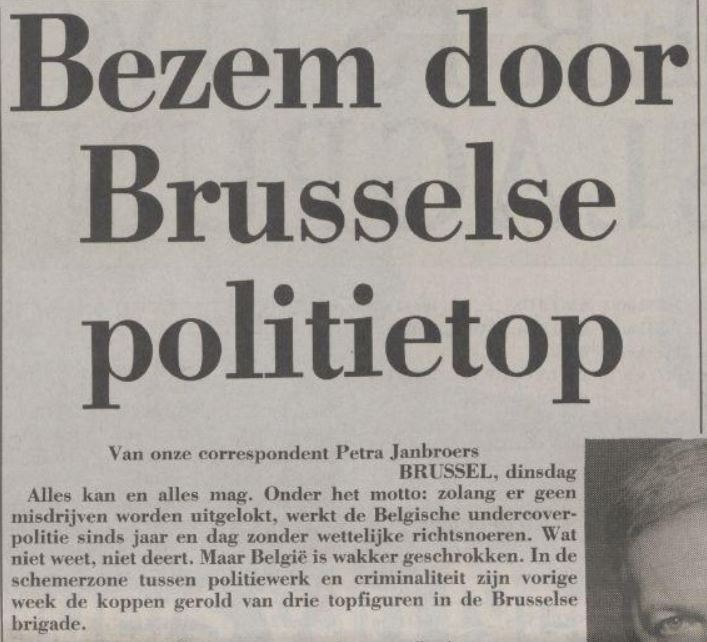 (...)  (...) |
|   | | HERVE
Nombre de messages : 21423
Date d'inscription : 08/12/2009
 |  Sujet: Re: Nicolas de Kerchove d’Ousselghem Sujet: Re: Nicolas de Kerchove d’Ousselghem  Sam 26 Mai 2018 - 15:38 Sam 26 Mai 2018 - 15:38 | |
|
Voir aussi :
https://www.delpher.nl/nl/kranten/view?query=ASCO+AND+BOAS&page=1&sortfield=datedesc&coll=ddd&identifier=ABCDDD%3A010856847%3Ampeg21%3Aa0453&resultsidentifier=ABCDDD%3A010856847%3Ampeg21%3Aa0453
|
|   | | HERVE
Nombre de messages : 21423
Date d'inscription : 08/12/2009
 |  Sujet: Re: Nicolas de Kerchove d’Ousselghem Sujet: Re: Nicolas de Kerchove d’Ousselghem  Lun 28 Mai 2018 - 11:04 Lun 28 Mai 2018 - 11:04 | |
| https://www.scribd.com/document/236806402/Celsius-Les-6-derniers-mois-du-ministre-VdB-1991-pdf (...)  (...) |
|   | | HERVE
Nombre de messages : 21423
Date d'inscription : 08/12/2009
 |  Sujet: Re: Nicolas de Kerchove d’Ousselghem Sujet: Re: Nicolas de Kerchove d’Ousselghem  Dim 1 Mai 2022 - 11:01 Dim 1 Mai 2022 - 11:01 | |
| |
|   | | HERVE
Nombre de messages : 21423
Date d'inscription : 08/12/2009
 |  Sujet: Re: Nicolas de Kerchove d’Ousselghem Sujet: Re: Nicolas de Kerchove d’Ousselghem  Dim 1 Mai 2022 - 11:44 Dim 1 Mai 2022 - 11:44 | |
| |
|   | | HERVE
Nombre de messages : 21423
Date d'inscription : 08/12/2009
 |  Sujet: Re: Nicolas de Kerchove d’Ousselghem Sujet: Re: Nicolas de Kerchove d’Ousselghem  Dim 1 Mai 2022 - 20:22 Dim 1 Mai 2022 - 20:22 | |
| |
|   | | HERVE
Nombre de messages : 21423
Date d'inscription : 08/12/2009
 |  Sujet: Re: Nicolas de Kerchove d’Ousselghem Sujet: Re: Nicolas de Kerchove d’Ousselghem  Dim 21 Aoû 2022 - 17:59 Dim 21 Aoû 2022 - 17:59 | |
| A côté de Nicolas de Kerchove d'Ousselghem lors d'une réunion du CEDI, le marquis de Valdeiglesias.  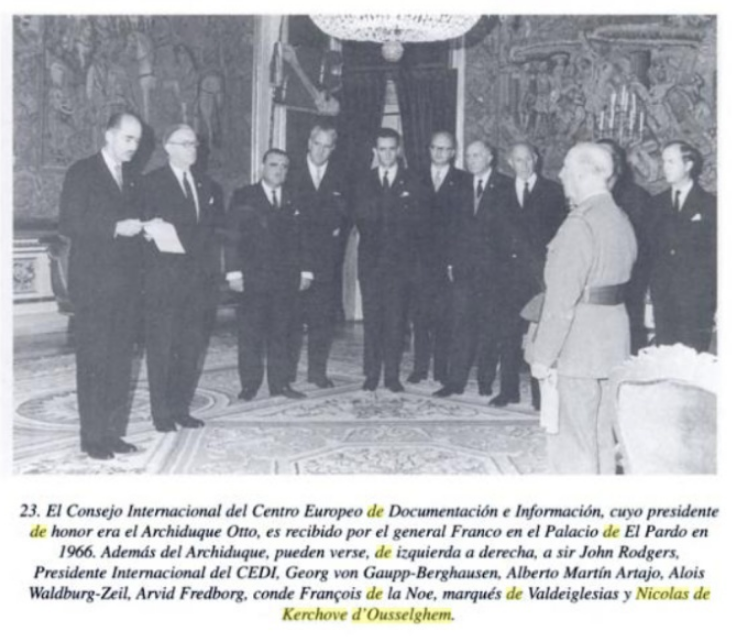 |
|   | | HERVE
Nombre de messages : 21423
Date d'inscription : 08/12/2009
 |  Sujet: Re: Nicolas de Kerchove d’Ousselghem Sujet: Re: Nicolas de Kerchove d’Ousselghem  Dim 21 Aoû 2022 - 20:24 Dim 21 Aoû 2022 - 20:24 | |
| https://www.cairn.info/revue-etudes-germaniques-2009-2-page-427.htm?contenu=resume (en allemand) Au moyen de la méthode des « biographies croisées », l’article analyse les structures de communication transnationale dans le milieu conservateur européen de l’après-guerre. Sont particulièrement prises en compte trois organisations : le Centre européen de documentation et d’information (CEDI), fondé en 1952 à l’initiative d’Otto de Habsbourg en Espagne franquiste, qui servit de forum de diplomatie parallèle aux gaullistes français durant les années 1950 et 1960 ; l’ Institut d’Études Politiques de Vaduz, une organisation plus restreinte lancée par plusieurs membres du CEDI en 1961 ; et Le Cercle, organisation énigmatique rassemblant des hommes politiques renommés de l’Europe et des États Unis, dont certains étaient des futurs acteurs de ladite «Affaire des avions renifleurs». _ _ _ (traduction) Le groupe pétrolier français Elf Aquitaine aurait ainsi investi un milliard de francs entre 1975 et 1979 dans le développement d'une technologie permettant de détecter des gisements de pétrole à partir d'avions. Ce n'est qu'après plusieurs accords avec les prétendus "inventeurs" de cette baguette de sourcier moderne, des années de paiements de plusieurs millions et quelques forages ratés que la direction de l'entreprise s'est rendu compte qu'elle avait été trompée. L'affaire était doublement explosive : D'une part, parce que dans un groupe dirigé par l'Etat, pratiquement tous les mécanismes de contrôle avaient échoué ; d'autre part, parce que selon le journal, un groupe renommé de politiciens et de managers était impliqué dans le scandale - dont Philippe de Weck, président du conseil d'administration de la société bancaire suisse, le grand industriel italien Carlo Pesenti, l'ancien Premier ministre français Antoine Pinay, l'ancien diplomate et ministre du tourisme espagnol Alfredo Sánchez Bella et même le président français de l'époque Valéry Giscard d'Estaing, qui avait approuvé les pratiques commerciales inhabituelles d'Elf Aquitaine. (...) De Yalta à Budapest - Le Centre Européen de Documentation et d'Information (CEDI) et son engagement pour la libération de l'Europe du communismeLe point de départ de mes réflexions est une organisation au nom aussi prometteur qu'évasif : le Centre Européen de Documentation et d'Information (CEDI). Note : voir aussi http://webs.ucm.es/BUCM/tesis//ghi/ucm-t28931.pdf Le CEDI a été créé en 1952 en Espagne, alors dirigée par le général Franco. Otto de Habsbourg, le fils aîné du dernier empereur Charles Ier d'Autriche-Hongrie, a été l'initiateur et le chef de l'organisation. Note : Stephan Baier und Eva Demmerle : Otto von Habsburg. Die Biographie, Wien : Amalthea, 2002, S. 239-241. Le CEDI devait rassembler différents groupes chrétiens conservateurs qui s'étaient formés en Europe occidentale sous le signe de la reconstruction, du début de la guerre froide et de l'intégration européenne naissante. Très vite, le "cercle d'amis" initial, à peine remarqué par le monde extérieur, s'est transformé en un important réseau de contacts transnational. Sous le prétexte d'échanges culturels et d'une appartenance "occidentale", le CEDI a permis à l'Espagne francophone, alors isolée en politique étrangère, de rencontrer régulièrement des conservateurs de premier plan d'Europe occidentale. Les congrès internationaux du CEDI - qui se tenaient la plupart du temps à l'Escorial, le château et le monastère emblématiques aux portes de Madrid - réunissaient chaque année des fonctionnaires et des dignitaires conservateurs de haut rang. Outre la section espagnole, à laquelle appartenaient plusieurs ministres et hauts fonctionnaires du régime franquiste, les représentants allemands se sont révélés particulièrement actifs au sein de cette "Internationale des conservateurs". Ils étaient à l'origine issus du milieu catholique et clérical de l' Abendländischen Akademie . (...) Le rôle de forum de discussion conservateur sur les sujets d'actualité et de politique mondiale a été progressivement repris par l'Institut d'Études Politiques, fondé en 1961 par les proches dirigeants du CEDI et basé à Vaduz. Sur le modèle des clubs politiques anglo-saxons, un cercle soudé de politiciens conservateurs, de managers et de stratèges militaires s'y réunissait en toute discrétion. Sous le patronage du Prince du Liechtenstein, ils échangeaient quatre week-ends par an sur les derniers développements dans les différents pays et au niveau international. Un autre forum politique, qui s'est réuni vers la fin des années 60 avec la participation de plusieurs membres de la CEDI, dont Otto de Habsbourg, semble nettement plus bizarre. Il portait le nom énigmatique de Le Cercle. À intervalles irréguliers, mais le plus souvent deux ou trois fois par an, des personnalités publiques très renommées d'Europe et d'Amérique du Nord se réunissaient dans ce cadre, dans des lieux différents. Dans le plus grand secret et sans contraintes d'organisation, elles pouvaient s'informer de leur vision de la situation politique mondiale. Les activités du Cercle laissent beaucoup de place aux spéculations et aux conjectures conspirationnistes, notamment en raison de leurs liens avec plusieurs services secrets. Parmi les participants, dont les noms n'ont été révélés qu'au début des années 1980 par une indiscrétion dans les rangs du gouvernement bavarois, on trouve Giulio Andreotti, plusieurs fois Premier ministre italien, Brian Crozier, un journaliste britannique influent, Henry Kissinger, David Rockefeller, Franz Josef Strauss et - ce qui nous ramène à l'"affaire des avions renifleurs" - Antoine Pinay, Alfredo Sánchez Bella et Carlo Pesenti. (...) _ _ _ Pour information : https://www.amazon.de/Del-imperio-Uni%C3%B3n-Europea-Biograf%C3%ADas/dp/843213158X 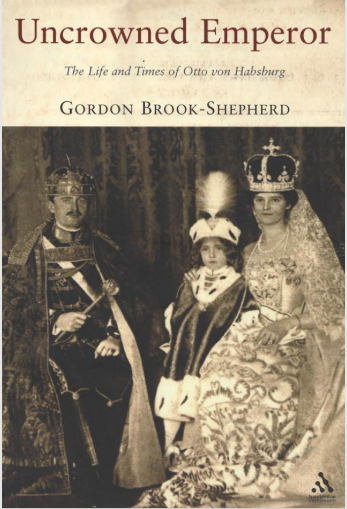 _ _ _ Rappel : https://archive.org/details/RiddersVanNuonvolledigAuteurAndreVanBosbeke/page/n3/mode/2up?q=Albert   |
|   | | HERVE
Nombre de messages : 21423
Date d'inscription : 08/12/2009
 |  Sujet: Re: Nicolas de Kerchove d’Ousselghem Sujet: Re: Nicolas de Kerchove d’Ousselghem  Jeu 2 Mar 2023 - 18:34 Jeu 2 Mar 2023 - 18:34 | |
| |
|   | | HERVE
Nombre de messages : 21423
Date d'inscription : 08/12/2009
 |  Sujet: Re: Nicolas de Kerchove d’Ousselghem Sujet: Re: Nicolas de Kerchove d’Ousselghem  Jeu 9 Mar 2023 - 18:18 Jeu 9 Mar 2023 - 18:18 | |
| 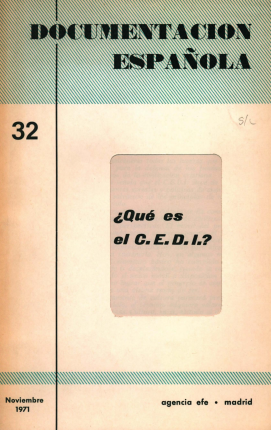 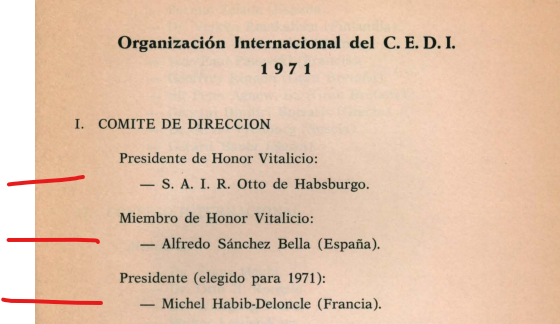 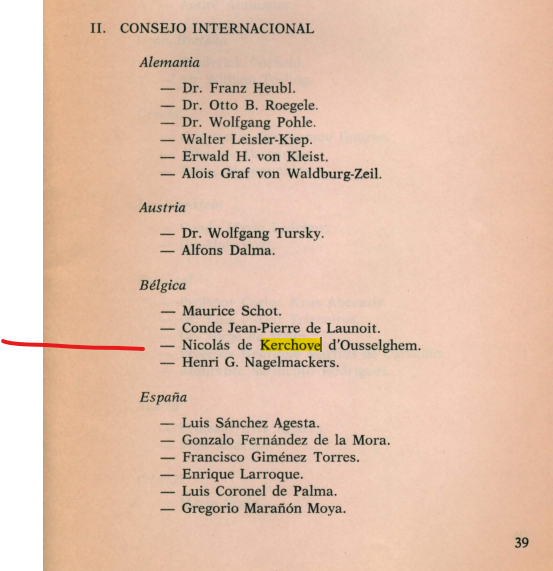 _ _ _ Michel Habib-Delonclehttps://fr.wikipedia.org/wiki/Michel_Habib-Deloncle (...) il est vice-président international de l'Union Paneuropéenne (Pan-Europe) et membre du Parlement européen de 1967 à 1973. Il est président international du Centre européen de documentation et d'information (CEDI) de 1971 à 1972. (...) https://fr.wikipedia.org/wiki/Deloncle https://fr.wikipedia.org/wiki/Eug%C3%A8ne_Deloncle Antoine Octave Eugène Deloncle est un homme politique français, né à Brest (Finistère) le 20 juin 1890 et mort à Paris le 7 janvier 1944, cofondateur de la Cagoule en 1935. Voir (en lien avec "la Cagoule") : https://fr.wikipedia.org/wiki/Henri_Martin_(militant_politique) et le livre " V " de Pierre Péan (1984), pour ce qui concerne Jean Violet. André Moyen a aussi été en contact avec "la Cagoule"... https://tueriesdubrabant.1fr1.net/t1160p700-moyen-andre |
|   | | HERVE
Nombre de messages : 21423
Date d'inscription : 08/12/2009
 |  Sujet: Re: Nicolas de Kerchove d’Ousselghem Sujet: Re: Nicolas de Kerchove d’Ousselghem  Jeu 13 Avr 2023 - 20:04 Jeu 13 Avr 2023 - 20:04 | |
| |
|   | | HERVE
Nombre de messages : 21423
Date d'inscription : 08/12/2009
 |  Sujet: Re: Nicolas de Kerchove d’Ousselghem Sujet: Re: Nicolas de Kerchove d’Ousselghem  Lun 6 Nov 2023 - 10:50 Lun 6 Nov 2023 - 10:50 | |
| |
|   | | HERVE
Nombre de messages : 21423
Date d'inscription : 08/12/2009
 | |   | | HERVE
Nombre de messages : 21423
Date d'inscription : 08/12/2009
 |  Sujet: Re: Nicolas de Kerchove d’Ousselghem Sujet: Re: Nicolas de Kerchove d’Ousselghem  Lun 6 Nov 2023 - 11:37 Lun 6 Nov 2023 - 11:37 | |
| |
|   | | Contenu sponsorisé
 |  Sujet: Re: Nicolas de Kerchove d’Ousselghem Sujet: Re: Nicolas de Kerchove d’Ousselghem  | |
| |
|   | | | | Nicolas de Kerchove d’Ousselghem |  |
|
Sujets similaires |  |
|
| | Permission de ce forum: | Vous ne pouvez pas répondre aux sujets dans ce forum
| |
| |
| |
